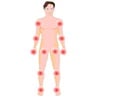As average life expectancy increases, osteoarthritis (OA), which is one of the ten most disabling diseases in the developed world, is set to become more of a financial burden on health services.
As average life expectancy increases, osteoarthritis (OA), which is one of the ten most disabling diseases in the developed world, is set to become more of a financial burden on health services.
OA is the most common form of arthritis, affecting nearly 27 million Americans or 12.1% of the adult population of the United States, according to Laurence et al.¹ A 2001 study showed that the disease costs US health services about $89.1 billion,2 and indirect costs relating to wages and productivity losses and unplanned home care averaged $4603 per person.3In a review for F1000 Medicine Reports, Yves Henrotin and Jean-Emile Dubuc examine the range of therapies currently on offer for repairing cartilaginous tissue. They also consider how recent technological developments could affect the treatment of OA in elderly populations.
The most promising therapeutic technique is Autologous Chondrocyte Implantation (ACI), which involves non-invasively removing a small sample of cartilage from a healthy site, isolating and culturing cells, then re-implanting them into the damaged area.
A recent enhancement to this method is matrix-assisted ACI (MACI) - where the cultured cells are fixed within a biomaterial before being implanted to promote a smooth integration with the existing tissues. ACI and MACI have previously been reserved for younger patients who are not severely obese (i.e. with a BMI below 35), whose cartilage defect is relatively small and where other therapies have already been tried.
Professor Henrotin said: "The huge financial burden emphasizes the acute need for new and more effective treatments for articular cartilage defects, especially since there are few disease modifying drugs or treatments for OA."
Given the encouraging results of the trials cited in this review, Henrotin says MACI/ACI therapies could be used to delay or prevent the need for total joint replacement in OA patients. However, it remains to be seen whether these techniques are superior in terms of risk and cost-effectiveness when compared with current alternatives.
Advertisement
Advertisement
RAS









